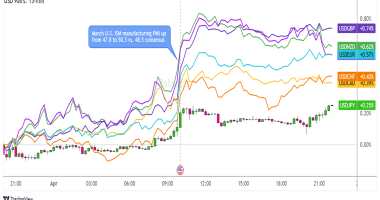Welcome to a brand spankin’ new trading month!
As in most months, the RBA will lead the central bank pack in sharing its latest monetary policy decisions.
What are markets expecting from RBA’s event and how can the central bank’s decision affect the Aussie’s price trends?
Event in Focus:
Reserve Bank of Australia (RBA) Monetary Policy Statement
When Will it Be Released:
June 6, 2023 (Tuesday): 4:30 am GMT
Use our Forex Market Hours tool to convert GMT to your local time zone.
Expectations:
- RBA to keep interest rates on hold at 3.85%
- RBA’s statement may emphasize that further tightening may still be required depending on economic and inflation data
Relevant Australian Data Since the Last RBA Statement:
? Arguments for Tighter Monetary Policy / Bullish AUD
Annualized monthly inflation accelerated from 6.3% y/y in March to 6.8% y/y in April (vs. 6.4% expected)
Wage price index showed another 0.8% quarter-over-quarter gain, short of the estimated 0.9% increase
Melbourne Institute’s consumer expected inflation rate accelerated from 4.6% to 5.0% in May
? Arguments for Looser Monetary Policy / Bearish AUD
Private capital expenditure slowed down from 3.6% in Q4 to a seasonally-adjusted 1.3% in Q1 2023
Retail sales were unchanged at 35.3B AUD in April and supported talks that retail spending has peaked in the last six months.
Flash manufacturing PMI unchanged at 48.0 in May
Flash services PMI dipped from upgraded 53.7 reading to 51.8 to reflect slower industry expansion
April employment change showed a surprise 4.3K in hiring losses versus an estimated 24.8K gain, the previous reading upgraded from 53K to 61.1K in employment gains, jobless rate up from 3.5% to 3.7%
Previous Releases and Risk Environment Influence on AUD
May 2, 2023
Action / results: AUD was trading inside its U.S. session ranges when the RBA surprised forex traders with a 25-basis point interest rate hike to 3.85% in May.
It turned out that the RBA thought a 7% inflation rate is still “too high” and that it would take YEARS for it fall to the central bank’s target range at the current rate of slowing.
In its statement, the RBA also noted that further tightening “may be required” to return inflation rates to its target “in a reasonable timeframe.”
The surprise tightening bumped AUD by more than 1.0% higher than its major counterparts.
Risk environment and Intermarket behaviors: Unfortunately for AUD bulls, banking contagion concerns dominated the day’s London and U.S. session trading.
Risk assets including U.S. equities, bitcoin, and commodity-related currencies crashed. AUD, in particular, dipped to new intraday lows and didn’t let up its downswings until near the end of the week.
Apr. 4, 2023
Action / results: The Aussie started the week off strong but wound up returning those early gains and more when the RBA announced its decision to pause from tightening.
In addition, their official statement toned down the hawkish rhetoric from “further tightening will be required” to “further tightening may well be needed” so many took this as a sign that policymakers will stand pat for much longer.
This was later on followed by RBA head Lowe’s speech, during which he cited that “the decision to hold rates steady this month does not imply that interest rate increases are over” and that “at our next meeting, we will again review the setting of monetary policy with the benefit of an updated set of forecasts and scenarios.”
Risk environment and Intermarket behaviors: It was a particularly busy week in terms of central bank decisions and top-tier economic releases, but price action leaned risk-off as the shortened trading week dragged on.
Resurfacing recession fears, stemming mostly from downbeat U.S. JOLTS job openings data, kept market players on edge and favoring lower-yielding currencies.
Price action probabilities
Risk sentiment probabilities: “Risk” assets like the Aussie have been on shaky ground against their safe haven counterparts as easing U.S. debt ceiling concerns put the spotlight back on growth jitters.
Specifically, key data misses from major economies *cough* China and Germany *cough* are bringing back concerns that the relatively high interest rate environment will choke global economic recovery.
If the risk-averse trading environment extends to next week, then AUD will trade in the same risk environment as in the last two meetings. It will be easier for AUD bears to pounce if the markets decide that RBA’s decision isn’t hawkish enough.
Australian Dollar scenarios
Base case: During his recent testimony to Australian policymakers, RBA Governor Lowe admitted that one reason why the central bank surprised with a rate hike in May was to reinforce the idea that the RBA remains committed to its battle against inflation.
But data-wise, the economy is still performing broadly within the central bank’s expectations.
While the annualized monthly inflation surprisingly accelerated from 6.3% to 6.8% in April, a closer look showed that excluding “volatile” items like holiday travel would put the CPI closer to 6.5%.
Meanwhile, the unexpected hiring losses and uptick in the jobless rate in April feeds into the RBA’s belief that inflation has peaked.
This is why RBA may keep its interest rates unchanged at 3.85% even as it warns of future rate hikes depending on economic data.
A “hawkish hold” amidst a risk-averse trading environment may lead to a spike during the report’s release and then possibly profit-taking (read: AUD losses) during the London and U.S. sessions.
In case of AUD weakness, consider selling the comdoll against safe havens like USD, JPY, and CHF, or its fellow comdoll counterparts like NZD and CAD if risk sentiment is leaning positive on the session.
Alternative Scenario: If RBA members feel like reinforcing their commitment to fighting high inflation one more time, then we may see another surprise rate hike from the central bank.
AUD could spike higher again and gain pips across the board during the Asian session.
Then, depending on the overall risk environment, the RBA’s rate hike could set the tone for AUD’s intraday uptrends or mark AUD’s intraday highs before going back to its daily open levels in the next trading sessions.
AUD strength is usually more visible against safe havens like USD and JPY, as well as AUD’s “twin” comdoll NZD during recent event releases.











